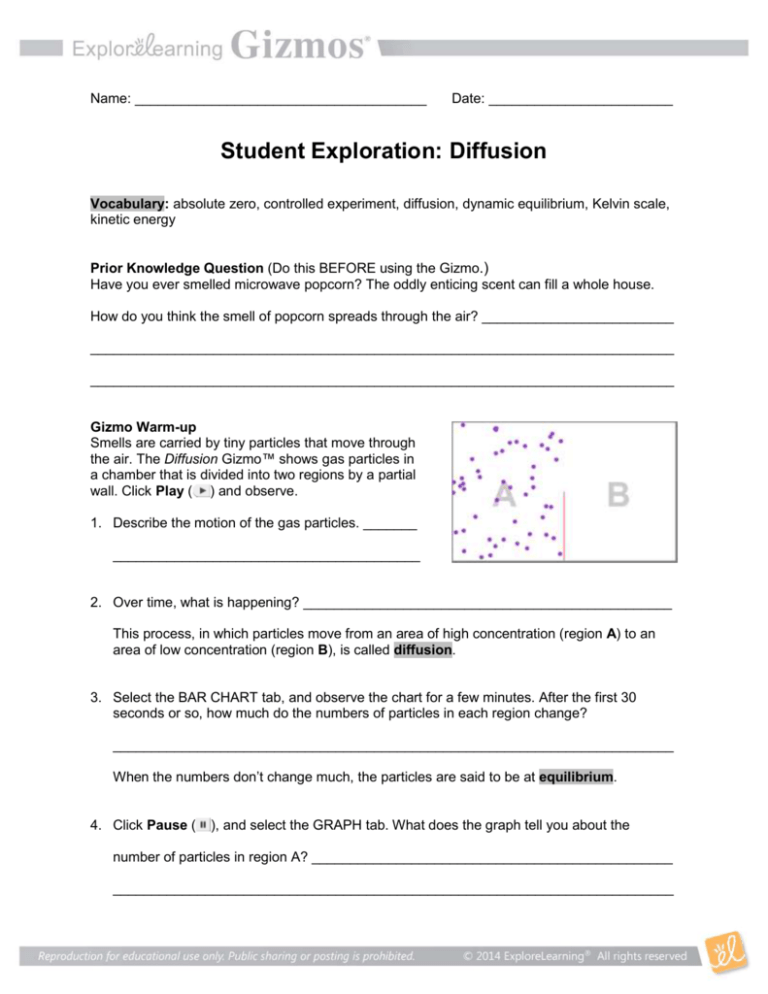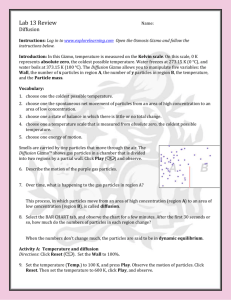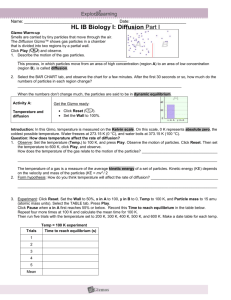Diffusion: Student Exploration Gizmo - Temperature & Rate
advertisement

Name: ______________________________________ Date: ________________________ Student Exploration: Diffusion Vocabulary: absolute zero, controlled experiment, diffusion, dynamic equilibrium, Kelvin scale, kinetic energy Prior Knowledge Question (Do this BEFORE using the Gizmo.) Have you ever smelled microwave popcorn? The oddly enticing scent can fill a whole house. How do you think the smell of popcorn spreads through the air? _________________________ ____________________________________________________________________________ ____________________________________________________________________________ Gizmo Warm-up Smells are carried by tiny particles that move through the air. The Diffusion Gizmo™ shows gas particles in a chamber that is divided into two regions by a partial wall. Click Play ( ) and observe. 1. Describe the motion of the gas particles. _______ ________________________________________ 2. Over time, what is happening? ________________________________________________ This process, in which particles move from an area of high concentration (region A) to an area of low concentration (region B), is called diffusion. 3. Select the BAR CHART tab, and observe the chart for a few minutes. After the first 30 seconds or so, how much do the numbers of particles in each region change? _________________________________________________________________________ When the numbers don’t change much, the particles are said to be at equilibrium. 4. Click Pause ( ), and select the GRAPH tab. What does the graph tell you about the number of particles in region A? _______________________________________________ _________________________________________________________________________ Get the Gizmo ready: Activity A: Temperature and diffusion Click Reset ( ). Set the Wall to 100%. Introduction: In this Gizmo, temperature is measured on the Kelvin scale. On this scale, 0 K represents absolute zero, the coldest possible temperature. Water freezes at 273.15 K (0 °C), and water boils at 373.15 K (100 °C). Question: How does temperature affect the rate of diffusion? 1. Observe: Set the temperature (Temp.) to 100 K, and press Play. Observe the motion of particles. Click Reset. Then set the temperature to 600 K, click Play, and observe. How does the temperature of the gas relate to the motion of the particles? ______________ _________________________________________________________________________ 2. Form hypothesis: How do you think temperature will affect the rate of diffusion? __________ _________________________________________________________________________ 3. Experiment: Click Reset. Set the Wall to 50%, x in A to 100, y in B to 0, Temp. to 100 K, and Particle mass to 15 amu (atomic mass units). Select the TABLE tab. Press Play. Click Pause when x in A first reaches 55% or below. Record this Time to reach equilibrium in the left table below. Repeat four more times at 100 K, and then run five trials with the temperature set to 600 K. Temp = 100 K experiment Trial Time to reach equilibrium Temp = 600 K experiment Trial 1 1 2 2 3 3 4 4 5 5 (Activity A continued on next page) Time to reach equilibrium Activity A (continued from previous page) 4. Calculate: Find the average time to reach equilibrium for each experiment: A. Average time to reach equilibrium at 100 K (add all the times to reach equilibrium and divide by 5) ________________________________ B. Average time to reach equilibrium at 600 K: (add all the times to reach equilibrium and divide by 5) ________________________________ 5. Draw conclusions: Compare the average times to reach equilibrium for each temperature. A. How did temperature affect the rate of diffusion? ____________________________ ___________________________________________________________________ ___________________________________________________________________ B. Why do you think this was the case? ______________________________________ ___________________________________________________________________ ___________________________________________________________________ Activity B: Rates of diffusion Get the Gizmo ready: Click Reset. Introduction: The Diffusion Gizmo allows you to manipulate five variables: the Wall, the number of x particles in region A, the number of y particles in region B, the temperature, and the Particle mass. Question: How do factors other than temperature affect the rate of diffusion? 1. Choose a variable: Pick a variable to investigate. Which one did you choose? ___________ 2. Form hypothesis: How do you think this variable will affect rates of diffusion? ____________ _________________________________________________________________________ _________________________________________________________________________ 3. Set up experiment: In a controlled experiment, only one variable is manipulated or changed. Set up your experiment so that there is just one difference between set-up A and set-up B. List the Gizmo settings you will use for each set-up below. ONLY CHANGE ONE VARIABLE IN SET-UP B. ALL THE OTHER VARIABLES SHOULD STAY THE SAME!!!! Set-up A Set-up B Wall _______________ Wall _______________ x in A _______________ x in A _______________ y in B _______________ y in B _______________ Temp. _______________ Temp. _______________ Particle mass _______________ Particle mass _______________ 4. Gather data: Use the Gizmo to fill in each table. As before, the “time to reach equilibrium” is the time it takes for the number of x particles in region A to reach 55% or lower. Set-up A Trial Time to reach equilibrium Set-up B Trial 1 1 2 2 3 3 4 4 5 5 (Activity B continued on next page) Time to reach equilibrium Activity B (continued from previous page) 5. Calculate: Find the average time to reach equilibrium for each experiment: C. Average time to reach equilibrium for set-up A: (add all the times to reach equilibrium and divide by 5) ____________ D. Average time to reach equilibrium for set-up B: (add all the times to reach equilibrium and divide by 5) ____________ 6. Draw conclusions: Compare the average times to reach equilibrium for each set-up. A. How did the variable you investigated affect the rate of diffusion? _______________ ___________________________________________________________________ ___________________________________________________________________ B. Why do you think this was the case? ______________________________________ ___________________________________________________________________ ___________________________________________________________________ ___________________________________________________________________









